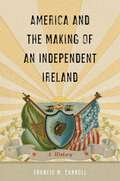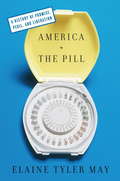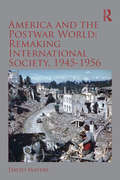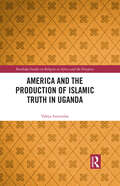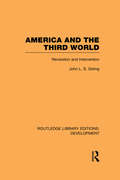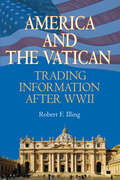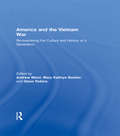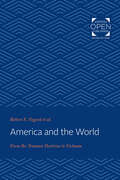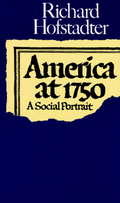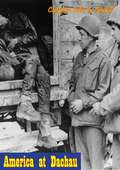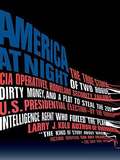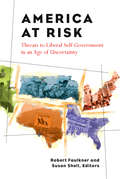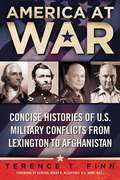- Table View
- List View
America and the Making of an Independent Ireland: A History (The Glucksman Irish Diaspora Series #1)
by Francis M. CarrollExamines how the Irish American community, the American public, and the American government played a crucial role in the making of a sovereign independent IrelandOn Easter Day 1916, more than a thousand Irishmen stormed Dublin city center, seizing the General Post Office building and reading the Proclamation for an independent Irish Republic. The British declared martial law shortly afterward, and the rebellion was violently quashed by the military. In a ten-day period after the event, fourteen leaders of the uprising were executed by firing squad.In New York, news of the uprising spread quickly among the substantial Irish American population. Initially the media blamed German interference, but eventually news of British-propagated atrocities came to light, and Irish Americans were quick to respond.America and the Making of an Independent Ireland centres on the diplomatic relationship between Ireland and the United States at the time of Irish Independence and World War I. Beginning with the Rising of 1916, Francis M. Carroll chronicles how Irish Americans responded to the movement for Irish independence and pressuring the US government to intervene on the side of Ireland. Carroll’s in-depth analysis demonstrates that Irish Americans after World War I raised funds for the Dáil Éireann government and for war relief, while shaping public opinion in favor of an independent nation. The book illustrates how the US government was the first power to extend diplomatic recognition to Ireland and welcome it into the international community.Overall, Carroll argues that the existence of the state of Ireland is owed to considerable effort and intervention by Irish Americans and the American public at large.
America and the Pill: A History of Promise, Peril, and Liberation
by Elaine Tyler MayIn 1960, the FDA approved the contraceptive commonly known as "the pill. ” Advocates, developers, and manufacturers believed that the convenient new drug would put an end to unwanted pregnancy, ensure happy marriages, and even eradicate poverty. But as renowned historian Elaine Tyler May reveals in America and the Pill, it was women who embraced it and created change. They used the pill to challenge the authority of doctors, pharmaceutical companies, and lawmakers. They demonstrated that the pill was about much more than family planning-it offered women control over their bodies and their lives. From little-known accounts of the early years to personal testimonies from young women today, May illuminates what the pill did and did not achieve during its half century on the market.
America and the Politics of Insecurity (Themes in Global Social Change)
by Andrew RojeckiAn innovative analysis of polarized politics post-9/11.In America and the Politics of Insecurity, Andrew Rojecki assesses the response of citizens and politicians to a series of crises that confronted the United States during the first decade of the twenty-first century. This period brought Americans face to face with extraordinarily difficult problems that were compounded by their origin in seemingly uncontrollable global forces. Rojecki establishes a theoretical framework for understanding how these new uncertainties contribute to increasingly polarized political discourse. Analyzing three domains of American insecurity—economic, environmental, and existential—Rojecki examines responses to the Great Recession by groups like the Tea Party and Occupy Wall Street; considers why the growing demand for fossil fuels makes people disregard global warming; and explores the desire for security measures that restrict personal freedom in the age of terrorism. Ultimately, he explains why the right has thus far held an edge over the left in the politics of insecurity.Rojecki concludes that in order to address these broad-scale political problems, we must reframe domestic issues as reactions to undiagnosed global conditions. Bringing the psychology of uncertainty together with contemporary case studies, this book is a sweeping diagnostic for—and antidote to—ineffective political discourse in a globalized world that imports bads as well as goods.
America and the Postwar World: Remaking International Society, 1945-1956 (Routledge Studies in Modern History)
by David MayersThe main tide of international relations scholarship on the first years after World War II sweeps toward Cold War accounts. These have emphasized the United States and USSR in a context of geopolitical rivalry, with concomitant attention upon the bristling security state. Historians have also extensively analyzed the creation of an economic order (Bretton Woods), mainly designed by Americans and tailored to their interests, but resisted by peoples residing outside of North America, Western Europe, and Japan. This scholarship, centered on the Cold War as vortex and a reconfigured world economy, is rife with contending schools of interpretation and, bolstered by troves of declassified archival documents, will support investigations and writing into the future. By contrast, this book examines a past that ran concurrent with the Cold War and interacted with it, but which usefully can also be read as separable: Washington in the first years after World War II, and in response to that conflagration, sought to redesign international society. That society was then, and remains, an admittedly amorphous thing. Yet it has always had a tangible aspect, drawing self-regarding states into occasional cooperation, mediated by treaties, laws, norms, diplomatic customs, and transnational institutions. The U.S.-led attempt during the first postwar years to salvage international society focused on the United Nations Relief and Rehabilitation Administration, the Acheson–Lilienthal plan to contain the atomic arms race, the Nuremberg and Tokyo tribunals to force Axis leaders to account, the 1948 Genocide Convention, the 1948 Universal Declaration of Human Rights, and the founding of the United Nations. None of these initiatives was transformative, not individually or collectively. Yet they had an ameliorative effect, traces of which have touched the twenty-first century—in struggles to curb the proliferation of nuclear weapons, bring war criminals to justice, create laws supportive of human rights, and maintain an aspirational United Nations, still striving to retain meaningfulness amid world hazards. Together these partially realized innovations and frameworks constitute, if nothing else, a point of moral reference, much needed as the border between war and peace has become blurred and the consequences of a return to unrestraint must be harrowing.
America and the Production of Islamic Truth in Uganda (Routledge Studies on Religion in Africa and the Diaspora)
by Yahya SserembaThis book investigates the ways in which the war on terror has transformed the postcolonial state in Africa. Taking American intervention in Islamic education in Uganda as the entry point, the book demonstrates how state control over Islamic truth production and everyday Muslim life has increased. During the colonial period, the Muslims in Uganda were governed in two ways: partly as lesser citizens within the Christian-dominated civil sphere and partly as members of a distinct Muslim domain. In this domain, a local system of Islamic education developed with a degree of autonomy that reflected the limits of the colonial state in shaping the Muslim subject. In the subsequent postcolonial period, systems of patronage and clientalistic networks dominated, and Muslim leaders were co-opted by the state, but without much real interference in the day-to-day lives of ordinary Muslims. However, as part of the war on terror, the US State Department seeks to bring the mechanisms of Islamic truth production, especially the madrasa, under direct state control and civil society scrutiny. This book argues that the "Muslim domain as a separate entity is coming to an end as it is being absorbed into the civil sphere, unifying the state’s domination of society." The book also analyzes local Ugandan Muslim initiatives to modernise and contextualize their own education and religion and how these initiatives are shaped by and transcend the dominant power. A thorough exploration of US foreign policy and Islamic education, this book will be of interest to students and scholars in the fields of Political Studies, African Studies and Religious Studies.
America and the Third World: Revolution and Intervention (Routledge Library Editions: Development)
by John GirlingJohn Girling’s book, first published in 1980, investigates the relationship between America and the Third World, centring on three main themes: the nature of American involvement in the Third World, the challenge posed by the rival Super-Power; and the Changes both in US-Soviet relations (from containment to détente) and in the Third World. Three propositions are put forward: that the overriding interest of American foreign policy maker is in the stability of the global system of relationships; that this interest coincides with most Third World élites; and that the global system normally operates peacefully, although continually subject to internal and external challenges.
America and the Vatican: Trading Information after World War II
by Robert F. IllingThe reader is given a rare view of the operations of the Vatican in the diplomatic world and some fascinating sidelights into the Vatican archives such as the role Benjamin Franklin played in the selection of the first Catholic Bishop in the United States and what the Pope actually intended to do about Henry the VIII. Robert Illing brings the reader into the fascinating and colorful political world of the Vatican, a unique entity with the dual nature of political state which functions apart from its other position as center of the Roman Catholic Church. A separate politcal state with diplomatic offices in most countries in the world, the Vatican has a unique position as a listening post unlike any other country in the world. Robert Illing brings the reader into that fascinating world.
America and the Vietnam War: Re-examining the Culture and History of a Generation
by Andrew Wiest Mary Kathryn Barbier Glenn RobinsThe Vietnam War was one of the most heavily documented conflicts of the twentieth century. Although the events themselves recede further into history every year, the political and cultural changes the war brought about continue to resonate, even as a new generation of Americans grapples with its own divisive conflict. America and the Vietnam War: Re-examining the Culture and History of a Generation reconsiders the social and cultural aspects of the conflict that helped to fundamentally change the nation. With chapters written by subject area specialists, America and the Vietnam War takes on subjects such as women’s role in the war, the music and the films of the time, the Vietnamese perspective, race and the war, and veterans and post-traumatic stress disorder. Features include: chapter summaries timelines discussion questions guides to further reading a companion website with primary source documents and tools (such as music and movie playlists) for both instructors and students. Heavily illustrated and welcoming to students and scholars of this infamous and pivotal time, America and the Vietnam War is a perfect companion to any course on the Vietnam War Era.
America and the World: Conversations on the Future of American Foreign Policy
by Zbigniew BrzezinskiAmerica’s status as a world power remains at a historic turning point. The strategies employed to win the wars of the twentieth century are no longer working, and the US must contend with the changing nature of power in a globalized world. In America and the World, two of the most respected figures in American foreign policy, Zbigniew Brzezinski and Brent Scowcroft, dissect the challenges facing the US today: the Middle East, Russia, and China, among others. In spontaneous conversations the two authors explore their agreements and disagreements. Defining the center of responsible opinion on American foreign policy, America and the World is an essential primer on a host of urgent issues at a time when our leaders’ decisions could determine how long our nation remains a superpower.
America and the World: Culture, Commerce, Conflict
by Lawrence A. Peskin Edmund F WehrleThis American history explores the country’s role as a globalizing force from the arrival of Columbus to the 21st century.The twenty-first century may be the age of globalization, but America has been at the cutting edge of globalization since Columbus landed here five centuries ago. In America and the World, Lawrence A. Peskin and Edmund F. Wehrle explore America's evolving connections with Europe, Africa, and Asia in the three areas that historically have been indicators of global interaction: trade and industry, diplomacy and war, and the "soft" power of ideas and culture. Divided into four historical phases of globalization, this book considers how international events and trends influenced American as well as how America exerted its own influence—whether economic, cultural, or military—on the world. The authors demonstrate how technology and disease enabled Europeans to subjugate the New World, how colonial American products transformed Europe and Africa, and how post-revolutionary American ideas helped foment revolutions in Europe and elsewhere. Peskin and Wehrle also explore America’s rise to global superpower, and how this power alienated people around the world and bred dissent at home. During the civil rights movement, America borrowed much from the world as it addressed the social issues of the day. At the same time, Americans—especially African Americans—offered a global model for change as the country grappled with racial and gender inequality.
America and the World: Culture, Commerce, Conflict
by Edmund F. Wehrle Lawrence A. PeskinAlthough the twenty-first century may well be the age of globalization, this book demonstrates that America has actually been at the cutting edge of globalization since Columbus landed here five centuries ago.Lawrence A. Peskin and Edmund F. Wehrle explore America's evolving connections with Europe, Africa, and Asia in the three areas that historically have been indicators of global interaction: trade and industry, diplomacy and war, and the "soft" power of ideas and culture. Framed in four chronological eras that mark phases in the long history of globalization, this book considers the impact of international events and trends on the American story as well as the influence America has exerted on world developments. Peskin and Wehrle discuss how the nature of this influence—whether economic, cultural, or military—fluctuated in each period. They demonstrate how technology and disease enabled Europeans to subjugate the New World, how colonial American products transformed Europe and Africa, and how post-revolutionary American ideas helped foment revolutions in Europe and elsewhere. Next, the authors explore the American rise to global economic and military superpower—and how the accumulated might of the United States alienated many people around the world and bred dissent at home. During the civil rights movement, America borrowed much from the world as it sought to address the crippling "social questions" of the day at the same time that Americans—especially African Americans—offered a global model for change as the country strove to address social, racial, and gender inequality. Lively and accessible, America and the World draws on the most recent scholarship to provide a historical introduction to one of today's vital and misunderstood issues.
America and the World: From the Truman Doctrine to Vietnam
by Robert E. OsgoodOriginally published in 1970. This volume presents a study of American foreign policy during the Cold War period, investigating the United States' involvement with the U.S.S.R., China, and communist parties throughout the world.
America and the World: Volume 9, Peace and Policy
by Majid Tehranian Kevin P. ClementsAs the world's first democracy with a written constitution and Bill of Rights, the United States has stood for global aspirations toward democratic liberty, equality, and solidarity since its formation in 1776. However, as it developed into an empire by the late nineteenth century, the United States also has threatened the liberties of other peoples, including Native Americans, Hawaiians, Latin Americans, Asians, and Africans. The American role in world affairs has long been polarized around two conflicting images and strategies. In the name of counter-terrorism, the Bush administration pursued a largely unilateralist policy in the Middle East and elsewhere. Yet, in the name of protecting its national sovereignty, the United States also has rejected most of the recent multilateral treaties that strive to contain violence by fortifying the rule of international law. A unilateralist strategy also goes largely against the U.S. postwar multilateralism, which established the United Nations and its specialized agencies. This volume explores these contradictions. Contributors include: Kevin P. Clements, Tom Coffman, Audrey Kitagawa, Jeffrey F. Addicott, Steven Zunes, Vivien Stewart, Kathy Ferguson, Phyllis Turnbull, Bilveer Singh, Ibrahim G. Aoude, Richard Falk, Ann Wright, Beverley Kleever, Linda Groff, George Kent, Majid Tehranian, Mohammad Ali, Terrence Paupp, Gillian Young, Mihay Simaii, and David Krieger. The annual publication Peace & Policy, sponsored by the Toda Institute for Global Peace and Policy Research, is now in its ninth year. It is dedicated to providing a forum for the discussion of all issues concerning peace, policy, and the rights and responsibilities of global citizenship. This latest volume fulfills that commitment.
America as Second Creation: Technology and Narratives of New Beginnings
by David E. NyeAfter 1776, the former American colonies began to reimagine themselves as a unified, self-created community. Technologies had an important role in the resulting national narratives, and a few technologies assumed particular prominence. Among these were the axe, the mill, the canal, the railroad, and the irrigation dam. In this book David Nye explores the stories that clustered around these technologies. In doing so, he rediscovers an American story of origins, with America conceived as a second creation built in harmony with God's first creation. While mainstream Americans constructed technological foundation stories to explain their place in the New World, however, marginalized groups told other stories of destruction and loss. Native Americans protested the loss of their forests, fishermen resisted the construction of dams, and early environmentalists feared the exhaustionof resources. A water mill could be viewed as the kernel of a new community or as a new way to exploit labor. If passengers comprehended railways as part of a larger narrative about American expansion and progress, many farmers attacked railroad land grants. To explore these contradictions, Nye devotes alternating chapters to narratives of second creation and to narratives of those who rejected it. Nye draws on popular literature, speeches, advertisements, paintings, and many other media to create a history of American foundation stories. He shows how these stories were revised periodically, as social and economic conditions changed, without ever erasing the earlier stories entirely. The image of the isolated frontier family carving a homestead out of the wilderness with an axe persists to this day, alongside later images and narratives. In the book's conclusion, Nye considers the relation between these earlier stories and such later American developments as the conservation movement, narratives of environmental recovery, and the idealization of wilderness.
America at 1750
by Richard HofstadterDemonstrates how the colonies developed into the first nation created under the influences of nationalism, modern capitalism and Protestantism.From the Paperback edition.
America at Dachau
by Chaplain John G. GaskillHarrowing account of U.S. Army chaplain John G. Gaskill of what he witnessed in Dachau.For three months, Gaskill ministered to liberated inmates and imprisoned SS soldiers at Dachau. Every evening for a month, Gaskill and other clergymen held mass funerals for those who died from starvation and disease. Gaskill tore down and kept the German sign forbidding entry to a mass grave on a hill. He replaced it with a cross and a Jewish star. He eventually made German prisoners bury the dead in separate graves in the cemeteries in town."At incredible Dachau, Chaplain Gaskill arranged for all the multitudinous services of the Ministry and Priesthood to be performed as necessary for many denominations in many different tongues. Although much has already been written about Dachau, this article, giving the experiences and observations of Chaplain Gaskill, paints an exceptionally vivid picture and presents it in a different light.--AUBREY L. BRADFORD Colonel MC Commanding."
America at Night
by Larry J. KolbA shocking true account only one man can tell, "the kind. . . about which fiction writers can only dream. "--New York Times When the Department of Homeland Security suspects that two former CIA operatives are at the center of plot involving money laundering and the funding of Al Qaeda-and when their supposedly comprehensive database turns up little to no information on either man-it takes onetime spy Larry Kolb to crack the case. But when Kolb begins to connect the dots, he realizes something even more sinister is afoot, and that he's on to the biggest possible con with the highest political stakes. America at Nightreads like a thriller, but the story is true and extensively documented. Kolb shows us how one well-informed individual did what all of our security agencies could not: trail two brilliant covert political operatives through a labyrinth of disguised identities and dark crimes to expose corruption at the highest levels.
America at Odds (6th Edition)
by Beth Henschen Edward SidlowKnown for its provocative and engaging issues approach, AMERICA AT ODDS, 6e, now features a groundbreaking new magazine-style format that greatly enhances its visual appeal and readability while remaining affordable and convenient. This unique text provides a memorable and effective introduction to American government by focusing on the current and historical conflicts and controversies that define America as a nation. AMERICA AT ODDS combines compelling content, innovative design elements, and powerful teaching tools to help you discover and refine your opinions through active discussion and debate of essential topics in American government and politics.
America at Risk: Threats to Liberal Self-Government in an Age of Uncertainty
by Robert Faulkner Susan ShellAmerica at Riskgathers original essays by a distinguished and bipartisan group of writers and intellectuals to address a question that matters to Americans of every political persuasion: what are some of the greatest dangers facing America today? The answers, which range from dwindling political participation to rising poverty, and religion to empire, add up to a valuable and timely portrait of a particular moment in the history of American ideas. While the opinions are many, there is a central theme in the book: the corrosion of the liberal constitutional order that has long guided the country at home and abroad. The authors write about the demonstrably important dangers the United States faces while also breaking the usual academic boundaries: there are chapters on the family, religious polarization, immigration, and the economy, as well as on governmental and partisan issues. America at Riskis required reading for all Americans alarmed about the future of their country. Contributors Traci Burch James W. Ceaser Robert Faulkner Niall Ferguson William A. Galston Hugh Heclo Pierre Manent Harvey C. Mansfield Peter Rodriguez Kay Lehman Schlozman Susan Shell Peter Skerry James Q. Wilson Alan Wolfe Robert Faulkner is Professor of Political Science at Boston College. Susan Shell is Professor of Political Science at Boston College. "America at Riskgoes well beyond the usual diagnoses of issues debated in public life like immigration, war, and debt, to consider the Republic’s founding principles, and the ways in which they have been displaced by newer thoughts and habits in contemporary America. A critical book for understanding our present condition. " -Francis Fukuyama, Bernard L. Schwartz Professor of International Political Economy, Johns Hopkins School of Advanced International Studies "In this penetrating book, the nation’s finest social and political thinkers from across the spectrum take a careful and no-holds-barred look at the dangers facing the American political system. The conclusions are more unsettling than reassuring---but that is because they are honest and real. " -Norm Ornstein, Resident Scholar, American Enterprise Institute "In the midst of overwrought pundits, irate soccer moms, and outraged bloggers, it is difficult to distinguish genuine dangers from false alarms and special pleading. This book enables us to do so, in a way that helps us to actually think about, not just feel anxious about, threats to those features of American society that are worth cherishing. The authors range in ideology and expertise, but they are uniformly judicious, incisive, and informative. This is a fascinating book about issues that the political system usually ignores or exaggerates. " -Jennifer L. Hochschild, Henry LaBarre Jayne Professor of Government and Professor of African and African American Studies, Harvard University
America at War
by Terence T. FinnWar--organized violence against an enemy of the state--seems part and parcel of the American journey. Indeed, the United States was established by means of violence as ordinary citizens from New Hampshire to Georgia answered George Washington's call to arms. Since then, war has become a staple of American history. Counting the War for Independence, the United States has fought the armed forces of other nations at least twelve times, averaging a major conflict every twenty years. In so doing, the objectives have been simple: advance the cause of freedom, protect U.S. interests, and impose America's will upon a troubled world. More often than not, the results have been successful as America's military has accounted itself well. Yet the cost has been high, in both blood and treasure. Americans have fought and died around the globe--on land, at sea, and in the air. Without doubt, their actions have shaped the world in which we live. In this comprehensive collection, Terence T. Finn provides a set of narratives--each concise and readable--on the twelve major wars America has fought. He explains what happened, and why such places as Saratoga and Antietam, Manila Bay and Midway are important to an understanding of America's past. Readers will easily be able to brush up on their history and acquaint themselves with those individuals and events that have helped define the United States of America.
America at War since 1945: Politics and Diplomacy in Korea, Vietnam, Iraq, and Afghanistan
by Gary A. DonaldsonFocusing primarily on politics and foreign policy, America at War since 1945 analyzes America's involvement in its several wars since the end of World War II. The main questions asked are: How did the U.S. become involved in these wars? How were the wars conducted? And how did the U.S. get out of these wars?In Korea and Vietnam, the US fought to show the world that it would stand up to the evils of communism-that it could be counted on (with money, advisors, or even a major military effort if necessary) to halt the advance of communism. But in both wars, the US showed itself to be militarily vulnerable. In its wars against radical Islam since 9/11, the United States has made use of its military to protect its interests in the Middle East, particularly its oil interests, while trying to spread its ideas of democracy, constitutionalism, and the rule of law. The lessons are clear: America's values often do not translate into the less-developed world.In 2016, as the debate over ISIS intensifies, America at War since 1945 reminds us that the history of US postwar military conflict has seldom been marked by clearly defined goals and outcomes. Skyhorse Publishing, as well as our Arcade imprint, are proud to publish a broad range of books for readers interested in history--books about World War II, the Third Reich, Hitler and his henchmen, the JFK assassination, conspiracies, the American Civil War, the American Revolution, gladiators, Vikings, ancient Rome, medieval times, the old West, and much more. While not every title we publish becomes a New York Times bestseller or a national bestseller, we are committed to books on subjects that are sometimes overlooked and to authors whose work might not otherwise find a home.
America at War with Itself
by Henry A. Giroux Robin D.G. KelleyFrom poisoned water and police violence in our cities, to gun massacres and hate-mongering on the presidential campaign trail, evidence that America is at war with itself is everywhere around us. The question is not whether or not it's happening, but how to understand the forces at work in order to prevent conditions from getting worse. Henry A. Giroux offers a powerful, far-reaching critique of the economic interests, cultural dimensions, and political dynamics involved in the nation's shift toward increasingly abusive forms of power. His analysis helps us to frame critical questions about what can and should be done to turn things around while we can.Reflecting on a wide range of social issues, Giroux contrasts Donald Trump's America with Sandra Bland's to understand who really benefits from politically fueled intolerance for immigrants, communities of color, Muslims, low-income families, and those who challenge state and corporate power. A passionate advocate for civil rights and the importance of the imagination, Giroux argues that only through widespread social investment in democracy and education can the common good hope to prevail over the increasingly concentrated influence of extreme right-wing politicians and self-serving economic interests.Praise for America at War with Itself:"This is the book Americans need to read now. No one is better than Henry Giroux at analyzing the truly dangerous threats to our society. He punctures our delusions and offers us a compelling and enlightened vision of a better way. America at War with Itself is the best book of the year."-Bob Herbert, Distinguished Senior Fellow at Demos and former Op-Ed columnist for the New York Times"In America at War with Itself, Henry Giroux again proves himself one of North America's most clear-sighted radical philosophers of education, culture and politics: radical because he discards the chaff of liberal critique and cuts to the root of the ills that are withering democracy. Giroux also connects the dots of reckless greed, corporate impunity, poverty, mass incarceration, racism and the co-opting of education to crush critical thinking and promote a culture that denigrates and even criminalizes civil society and the public good. His latest work is the antidote to an alarming tide of toxic authoritarianism that threatens to engulf America. The book could not be more timely."-Olivia Ward, Toronto Star"The current U.S. descent into authoritarianism did not just happen. As Henry Giroux brilliantly shows it was the result of public pedagogical work in a number of institutions that were part of a long-standing assault on public goods, the social contract, and democracy itself. Giroux powerfully skewers oppressive forces with the hallmark clarity and rigor that has made him one of the most important cultural critics and public intellectuals in North America. His sharp insights provide readers with the intellectual tools to challenge the tangle of fundamentalisms that characterize the political system, economy, and culture in the current conjuncture. America at War with Itself makes the case for real ideological and structural change at a time when the need and stakes could not be greater. Everyone who cares about the survival and revival of democracy needs to read this book."-Kenneth Saltman, Professor, University of Massachusetts Dartmouth, Author of The Failure of Corporate School ReformHenry A. Giroux's most recent books include The Violence of Organized Forgetting and America's Addiction to Terrorism. A prolific writer and political commentator, he has appeared in a wide range of media, including the New York Times and Bill Moyers.
America at War: Military Conflicts, Home and Abroad, and Daily Life in the 1800 (Daily Life in America in the 1800s)
by Matthew StrangeFrom an isolated and inward-looking new nation clinging to the East Coast, America in the 1800s grew in size, strength, and military might. From the War of 1812 to the century-long campaigns of conquest against Native American peoples, territorial expansion through war with Mexico to the great national tragedy that was the Civil War, American soldiers and sailors forged a tradition of pride and heroism that is part of our national heritage. Sometimes misguided, sometimes truly inspired, nineteenth-century America produced some of the greatest military leaders and witnessed some of the bloodiest battles in our history. Behind the scenes, and often neglected in our official histories, the life of America's citizen soldiers was a tough and brutal one. Patriotism, heroism, and human folly all combine in the story of the roots of America's rise to the status of world military power.
America at the Ballot Box
by Julian E. Zelizer Gareth DaviesElections are, and always have been, the lifeblood of American democracy. Often raucous and sharply contentious, sometimes featuring grand debates about the nation's future, and invariably full of dramatic moments, elections offer insight into the character and historical evolution of American politics. America at the Ballot Box uses the history of presidential elections to illuminate American political democracy and its development from the early Republic to the late twentieth century.Some of the contributions in America at the Ballot Box focus on elections that resulted in dramatic political change, including Jefferson's defeat of Adams in 1800, the 1860 election of Lincoln, and Reagan's 1980 landslide victory. Others concentrate on contests whose importance lies more in the way they illuminate the broad, underlying processes of political change, such as the corruption controversy of Cleveland's acrimonious election in 1884 or the advent of television advertising during the 1952 campaign, when Eisenhower defeated Stevenson. Another set of essays takes a thematic approach, exploring the impact of foreign relations, Anglophobia, and political communications over long periods of electoral time. Uniting all of the chapters is the common conviction that elections provide a unique vantage point from which to view the American political system.Ranging from landmark contests to less influential victories and defeats, the essays by leading political historians seek to rehabilitate the historical significance of presidential elections and integrate them into the broader evolution of American government, policies, and politics.Contributors: Brian Balogh, Gareth Davies, Meg Jacobs, Richard R. John, Kevin M. Kruse, Jeffrey L. Pasley, Andrew Preston, Elizabeth Sanders, Bruce J. Schulman, Jay Sexton, Adam I. P. Smith, Sean Wilentz, Julian E. Zelizer
America at the Fair: Chicago's 1893 World's Columbian Exposition
by Chaim M. RosenbergAt the time of the World's Columbian Exposition of 1893, the United States was fast becoming the world's leading economy. Chicago, the host city, had grown in less than half a century from a village to the country's second-largest metropolis. During this, the Gilded Age, the world's most extensive railroad and steamship networks poured ceaselessly through Chicago, carrying the raw goods and finished products of America's great age of invention and industrial expansion. The Fair was the largest ever at the time, with 65,000 exhibitors and millions of visitors. It has been called the "Blueprint of the American Future" and marked the beginning of the national economy and consumer culture.
